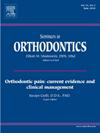A dual-layered 3D-printed appliance for pre-surgical orthopedics in infants with cleft lip and palate
IF 2.2
4区 医学
Q2 DENTISTRY, ORAL SURGERY & MEDICINE
引用次数: 0
Abstract
Objective
This clinical protocol paper introduces a dual-layered Presurgical Infant Orthopedics (PSIO) technique, designed to improve treatment outcomes for infants with Cleft Lip and Palate (CLP). The protocol utilizes a combination of an outer hard splint layer and an inner soft splint layer, fabricated using virtual construction and 3D printing. This approach aims to overcome the limitations of traditional PSIO methods by offering digitally customized, biocompatible appliances.
Materials and Method
The PSIO technique was applied to two cases: a 14-day-old male with bilateral CLP and a 26-day-old female with unilateral CLP on the left side. Fabrication involved intraoral scanning to create a digital model, followed by planning of molding vectors and 3D printing of the dual-layered appliances. Each layer was sequentially printed using distinct materials suited to their functional requirements. The treatment duration extended over five months for both cases.
Results
In the bilateral CLP case, the PSIO appliance facilitated increased lateral sulci distance, reduced intertuberosity width, medialization of the premaxilla, and approximation of the alveolar segments. This resulted in notable improvements in nasal symmetry and a reduction in the cleft gap prior to surgery. The unilateral CLP case demonstrated significant cleft gap reduction, enhanced nasal symmetry, and increased intercanine width.
Conclusions
The proposed dual-layered PSIO technique represents a significant advancement in the presurgical management of infants with CLP by incorporating digitally designed and directly 3D-printed appliances. This approach offers streamlined molding, minimizes caregiver burden, and reduces the risk of mucosal irritation while delivering precise and predictable treatment outcomes. Although promising, this protocol is based on case reports, and clinical trials are needed to further validate its effectiveness.
求助全文
约1分钟内获得全文
求助全文
来源期刊

Seminars in Orthodontics
DENTISTRY, ORAL SURGERY & MEDICINE-
CiteScore
2.20
自引率
4.80%
发文量
28
审稿时长
10 days
期刊介绍:
Each issue provides up-to-date, state-of-the-art information on a single topic in orthodontics. Readers are kept abreast of the latest innovations, research findings, clinical applications and clinical methods. Collection of the issues will provide invaluable reference material for present and future review.
 求助内容:
求助内容: 应助结果提醒方式:
应助结果提醒方式:


